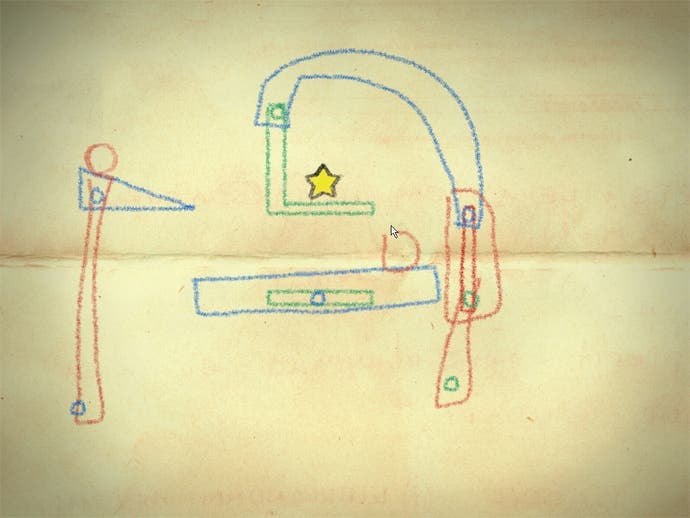Crayon Physics Deluxe
IGF Finalists 2008: Back to the drawing board.
We've done Audiosurf and World of Goo, two of the Seumas McNally Grand Finalists at the Independent Games Festival next month, and now we come to our early favourite, Crayon Physics Deluxe. Drawing is best.
In my house we have a phrase. Well, in my house we have about four hundred phrases, including, "Mmmm-mmmm, so good", "That light bulb had one day left 'til retirement", and "Shotgun!" But today we're discussing "PHYSICS!"
This phrase is shouted at specific moments, rather than some sort of Oxbridge version of Tourette's. It's when we drop something, or something falls over, or the cat falls off his elaborate cat tree. Anything that exhibits the properties of gravity will be met by this cheer. And why? Because physics are best. And that, in a big way, is why Crayon Physics Deluxe is looking so great.
Another big part is just how remarkably charming the whole thing is. Here's the idea: you have a little crayon circle that needs to reach a crayon star. Your task is to draw crayon shapes that, once drawn, behave in the world according to that-there physics. If you played the under-rated Pac-Pix, imagine it combined with 1993's The Incredible Machine. (That's the most perfect comparison imaginable, for the seven other people who will have played both.)

There's something sublimely magical about drawing something and having it come to life. It's like being Penny Crayon without the squawking horror of Su Pollard providing your voice. Combined with the childhood pleasure of the thick, comforting lines of a crayon, you've got a puzzle game that hurts your brain while making you feel warm and safe at the same time.
If you played Kloonigames' Crayon Phyics (and if you didn't, go and play it for free so you have a much better idea what this is about), you'll know that the concept was wonderful, the delivery a little limited. It can only generate oblongs, which often provides frustration. The splendid news is, Crayon Physics Deluxe makes some dramatic steps forward.
Things start easily enough. You can draw blocks that allow the ball to roll down a slope, after dropping another block on the ball to get it rolling. Draw a sloping triangle if you prefer. Or how about a big circle to roll along? And as you progress, far more elaborate and joyful complexities reveal themselves. How about drawing a small pivot, and then building a seesaw? Or perhaps you'll create a giant golf club that swings around and knocks the ball into the air? You can use pivots to dangle blocks from other structures, and then attach these together to create incredibly wobbly bridges. In fact it's building the most astonishingly stupid and over-complicated solutions to puzzles, involving elaborately peculiar mechanisms, that's most rewarding. There's almost certainly a much more sensible way to complete the level, but damn it, your way worked. And that means you're as great as Isambard Kingdom Brunel.

The build we have is still not finished, and there are still some issues in there. The most easily fixed is the lack of options, such as turning the music off. But that does lead to an interesting discovery. The piece of music used in this, and the previous Crayon Physics game, is just wonderful. I have listened to it on a loop for quite a few hours now, and it took a really long time before I needed it to go away. That's quite remarkable, considering normally the first thing I do with any puzzle game is switch it to silence. Some more tunes of this standard would be very splendid.
There's also a slight issue with more complicated shapes. Some odd-shaped blocks will confuse things, and cause objects to float awkwardly. Clearly this opens up opportunities for interesting exploits, but it also can prevent some neat solutions from working. However, this is a minor niggle, especially when compared with the leaps and bounds the technology has taken from Kloonigames' previous build.
Most of all, even playing this in-progress build, what's clear is quite how lovely Crayon Physics Deluxe is going to be. It's a warm, cuddly experience, but also a fantastically well-designed one. The puzzles start off simple, and introduce new concepts matching the difficulty curve.

But that isn't to say you don't get stuck. I wonder if we've almost forgotten how to get stuck in games, as if it's at fault if we're not continually progressing. CPD reminds you of the joy of not knowing what to do next, or how to do next I suppose. This is possibly because of the vast amount of potential on offer, with your imagination in place as the limitation. So the ball's at the bottom of the screen, and the star's at the top, and you've got gravity to defeat. It's going to take some experimentation, some improvisation, before you can fathom a way to reach the goal. But all the while with the calming nature of the whole thing, preventing rage.
Nominated for the top prize (and Best Student category) at the IGF awards, it faces some tough competition, not least from World of Goo. But it's a very worthy entry, and likely an unmissable game when finished code is revealed.


